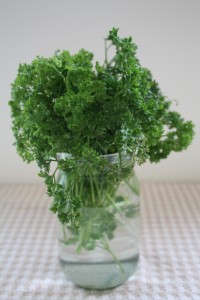Growing Parsley (petroselinum crispum) is one of those herb everyone should grow in there garden. It can be used as a culinary herb as well as a beautiful border plant.
Growing Parsley is a great way to have one of the most popular and oldest well known herbs. Remember when you were a kid and told to clean your plate? I wonder if they meant the garnish, properly not. Which is a shame because parsley is loaded with vitamin and minerals. Parsley is high in vitamin A, C, iron and minerals.
There are two kinds of parsley, curly and flat leaf Italian. Curly parsley has a milder taste, where Italian has a stronger flavor and most used by cooks.
Growing Parsley: Sow from spring to late summer, in zones 5-8. It grows to a height about 12-20″ tall depending on the variety. Italian is taller of the two plants. Can be grown indoors. Bi-annual which means the second year it goes to seed, so for best results plant parsley every year. By planting every year it will be available whenever it is needed. Parsley can be grown in containers near the kitchen, or in your garden. Likes full sun to part shade.
Parsley will bloom the second year with white tiny flowers umbels. Flowering usually occurs from early to midsummer.
Soil: should be rich and moist. Parsley likes to be grown in slightly alkaline and well drained soil.
Growing Parsley Seeds: The parsley seed is slow to germinate, in fact it may take as many as four weeks to germinate. The length of time for germination can be increase by soaking the seeds in a wet paper towel overnight or for several hours. Germination is about 70% and should start coming up in about 2 weeks if seeds have been soak.
Seeds need a cold spell, so if you collect the seeds they need to be in the refrigerator for a few weeks. Purchase seeds usually have been stratified (cold).
Seeds can be grown directly outside in spring or early early spring indoors. The plants can take cold better than some herb plants. They don’t like their roots disturbed so be careful when transplanting outside.
Harvest: Pick leaves and stems as needed the first year. Parsley can be cut severely several times a year if you give it about six weeks to recover. Parsley can be dried and or frozen. Parsley does well in both situations. Some herbs lose all flavor when dried, but parsley still retains some flavor. Store parsley in a cool dark place, light and heat will destroy flavor.
Culinary: Add raw flat leaf parsley to almost any savory dishes. Parsley makes a wonderful garnish for soups, salads, eggs dishes, potatoes, fish, sandwiches, and sauces. Curly parsley is one of the ingredient in bouquet garni. Check out my blog on “fine herbs and bouquet garni”. Parsley should be added at the last minute to retain it flavor. Check out my blog on “Fresh herbs in the Kitchen”.
The basic rule for using parsley is 1 TBSP. fresh or 1 to 2 tsp. dried.
Pests: Prone to suffer from leaf spot and viral diseases that may damage the leaves.
Companion Planting: Growing parsley can be used as a companion plants for roses, chives, tomatoes, and asparagus. Avoid fennel and dill when growing parsley.
Cosmetic: Can be infused as a hair tonic and conditioner. Add to facial steams and lotions for dry skin to minimize freckles.
Medicinal: Parsley is used in infusion, tinctures, cider vinegar tinctures and teas. Parsley is a antioxidant and is beneficial to the digestive tract and is often recommended for urinary tract problems.
Curly parsley is eaten for bad breath, which is one of the reason you find it as a garnish. It is also used to promote healthy skin. Use in a poultice as an antiseptic dressing for sprains, wounds, and insect bites.
Root: Use for kidney troubles and as a mild laxative.
History: Growing Parsley was held in high esteem by the Greeks and was used to crown the winning athletes.
Parsley is native to the Mediterranean and introduced in Britain and north and central Europe. Parsley was used in funeral ceremonies long before it was used as a garnish.
Growing parsley can be a wonderful addition to any garden, I hope these tips help you the next time you plant parsley.

